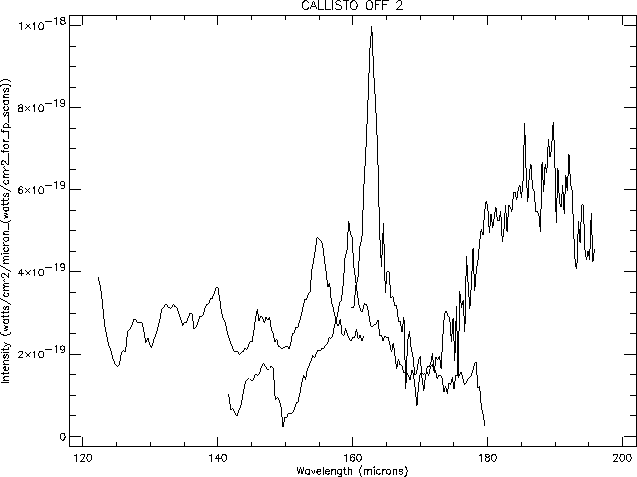Spurious emission features appear on the LWS spectra from the longest wavelength detectors (LW3, LW4 and LW5) in observations taken towards the end of the mission. An example of a spectrum affected by these features is shown in Figure 6.6.
A systematic investigation by the LWS Instrument Team led to the identification of the features in the following observations (TDT numbers):
65401108, 65601407, 66401804, 66500305, 66500306, 66801524, 66801525, 67100301, 67301203, 67301222, 67301223, 67501340, 67501357, 68500805, 68501504, 68701144, 68900805, 68900806, 70301315, 70302001, 70302002, 70302104, 70302105, 70302225, 70601702, 70601904, 71301708, 73700762, 73701360, 73701459, 74601203, 74802710, 74802912, 74803403, 74901722, 74901723, 75002331, 75002332, 75002333, 75400423, 75601535, 79000702, 80401605, 81301224, 81301225, 81301226, 81301227, 81301228 81301301, 81601413.
Note however that this list is not exhaustive; in particular the features have been recognized only in L01 spectra, since the wavelength ranges covered in L02 and L04 spectra are too small to be able to distinguish these features. For L03 data no systematic search for the presence of these features has been carried out.
The features are broad (a few ![]() m) emissions
centred near
m) emissions
centred near ![]() on detector LW3,
on detector LW3, ![]() on detector LW4,
and
on detector LW4,
and ![]() on detector LW5. In addition to them, a rise in flux can
be seen on the LW5 detector longward of
on detector LW5. In addition to them, a rise in flux can
be seen on the LW5 detector longward of ![]() . The features are more
visible on rather faint sources (typically less than a few
10
. The features are more
visible on rather faint sources (typically less than a few
10![]() W cm
W cm![]()
![]() m
m![]() at 160
at 160![]() m), since
the peak strength of the features is a few times
10
m), since
the peak strength of the features is a few times
10![]() W cm
W cm![]()
![]() m
m![]() . The biggest problem of
these features is that the one on the LW4 detector blends with the
157
. The biggest problem of
these features is that the one on the LW4 detector blends with the
157![]() m [C II] line.
m [C II] line.

|
A detailed examination of the cause of these anomalies has shown that they are associated with a simultaneous increase in dark current, noise and spontaneous spiking on the stressed detectors and a decrease in the current required to maintain the temperature of the stressed detector mount. This all indicates that the temperature of the stressed detector mount, which is connected to the helium tank, did not recover to the nominal value following the illuminator flash at the begining of the observations. An increase of only a few hundred milli-Kelvins is sufficient to radically change the dark current and noise performance of the stressed detectors. The straylight features themselves appear to be due to radiation from a source of 8 K located somewhere in the vicinity of the detector block - possibly radiating through the holes in the back of the instrument. The theory advanced to explain the change in the thermal balance of the instrument is that the liquid helium film in the tank broke periodically in the vicinity of the LWS strap location as the tank came close to exhaustion. The radiation and conducted heat from the illuminators then caused the detector block to warm up with little or no cooling power available from the LHe tank. As the observations progressed the detectors can be seen to return to there nominal state but, unfortunately, the stressed detector data from the observations affected are effectively useless as the changes in responsivity, dark current and the spontaneous spiking mean that they cannot be calibrated in any meaningful way.